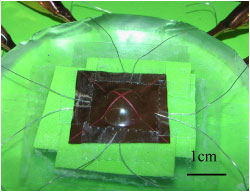The technology is aimed at development of a mechanosensor based on electro-active polymer (EAP), that can sense vectorial forces (3D forces).
Organization: University of Washington
PI: Patrick Shelby
Industry Market: Bio-engineering and prosthetics
Technology Contact: P. Shelby, University of Washington, US
The technology is aimed at development of a mechanosensor based on electro-active polymer (EAP), that can sense vectorial forces (3D forces). It is composed of arrayed Flemion tactile sensor units, able to detect forces using four patterned electrodes. The mechanosensor is skin-like, thus compatible with the human body. Patrick Shelby, Technology Manager at the University of Washington, tells NWN that the provisional patent for the Tactile Sensor technology was recently converted into a full US patent application.

Image of a single tactile sensor unit (black center area). Courtesy of the University of Washington
The market for prosthetics will continue to grow at a strong rate; Mr. Shelby notes to NWN, “The U.S. market for prosthetics, orthotics and cosmetic enhancement products is expected to increase from $6.8 billion in 2005 to $10.8 billion in 2010. Due to a convergence of technological, demographic, cultural and economic factors, we feel the prosthetics, orthotics and cosmetic enhancement products industries are entering into a period of extraordinary opportunities.”
The next steps for developing Tactile Sensors includes: